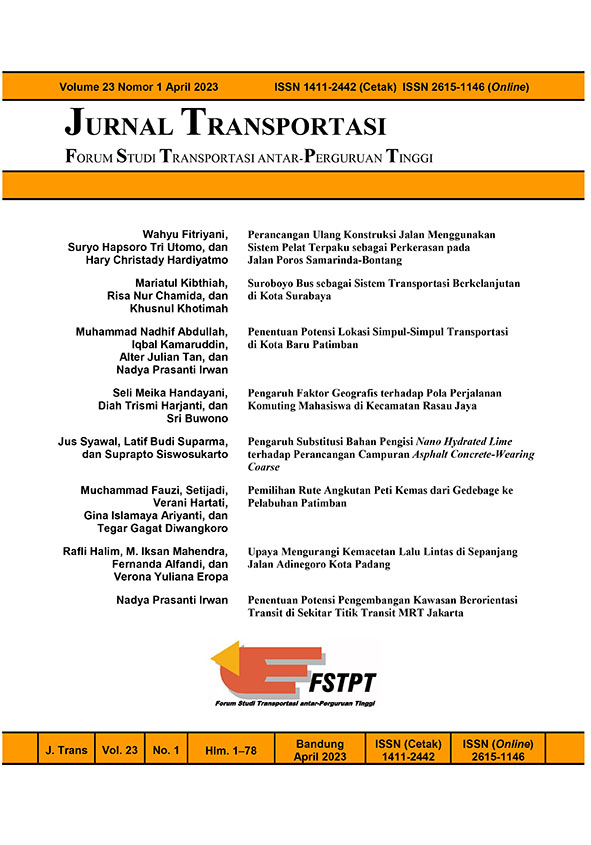PERANCANGAN ULANG KONSTRUKSI JALAN MENGGUNAKAN SISTEM PELAT TERPAKU SEBAGAI PERKERASAN PADA JALAN POROS SAMARINDA-BONTANG
DOI:
https://doi.org/10.26593/jtrans.v23i1.6641.1-10Abstract
Abstract
Section SP.3 Lempake–SP.3 Sambera is the section with the highest traffic volume on Jalan Poros Samarinda–Bontang, resulting in a lot of pavement damage. The damage to the road segment was caused by several factors, namely heavy vehicles, poor soil characteristics, non-functioning drainage, and the road section is located in the lowlands. The purpose of this research is to design a nailed slab system as a pavement to be used as an alternative to road pavement. The design was carried out using the AASHTO method and the Beam on Elastic Foundation method, with the load P at the center and at 0.30 m from the edge of the plate. The equivalent modulus reaction obtained for the AASHTO method was 48,515.785 kN/m³ and the resulting pavement slab thickness was 32.26 cm. While the Beam on Elastic Foundation method uses an equivalent modulus reaction value of 127,715.785 kN/m³ and the resulting pavement slab thickness is 20 cm. However, nailed slab system pavements are more expensive, because the total cost to be incurred is IDR 549,846,268,988, which is much higher than the total cost for conventional pavements, which is IDR 292,549,365,858.
Keywords: road pavement; rigid pavement; nailed slab system; conventional pavement.
Abstrak
Ruas SP.3 Lempake–SP.3 Sambera merupakan ruas dengan volume lalu lintas tertinggi di Jalan Poros Samarinda–Bontang, sehingga mengalami banyak kerusakan. Kerusakan pada ruas jalan tersebut disebabkan oleh beberapa faktor, yaitu kendaraan berat, karakteristik tanah yang kurang baik, drainase tidak berfungsi, dan ruas jalan terletak di dataran rendah. Tujuan penelitian ini adalah merancang sistem pelat terpaku sebagai perkerasan untuk dijadikan alternatif perkerasan jalan. Perancangan dilakukan dengan metode AASHTO dan metode Beam on Elastic Foundation, dengan beban P di pusat dan di 0,30 m dari tepi pelat. Nilai modulus reaksi ekivalen yang diperoleh untuk metode AASHTO adalah 48.515,785 kN/m³ dan tebal pelat perkerasan yang dihasilkan adalah 32,26 cm. Sedangkan metode Beam on Elastic Foundation menggunakan nilai modulus eaksi ekivalen 127.715,785 kN/m³ dan tebal pelat perkerasan yang dihasilkan adalah 20 cm. Akan tetapi, perkerasan sistem pelat terpaku lebih mahal, karena total biaya yang harus dikeluarkan adalah Rp549.846.268.988, yang mana nilai ini jauh lebih besar daripada total biaya untuk perkerasan konvensional, yaitu Rp292.549.365.858.
Kata-kata kunci: perkerasan jalan; perkerasan kaku; sistem pelat terpaku; perkerasan konvensional.


